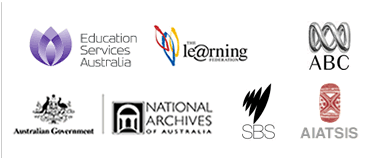Original classification rating: PG.
This clip chosen to be PG
Clip description
Damien Parer’s first taste of battle was with the British infantry in the Middle East. He quickly learned that if he wanted to get the shots that best showed men in action, then he needed to be up there on the front-line with the troops.
Curator’s notes
Damien Parer learnt his moving camera craft on the battlefield because he’d had so little experience using the movie camera in Australia before the war, where the film industry was moribund. Before the war, Parer had turned to still photography to keep his skills alive, working for the great Max Dupain, who recalls Parer’s work habits and devotion to his camera.
When the Second World War broke out in 1939, Parer became a junior cameraman with the Commonwealth Film Unit and it’s from here that he was able to travel to the various war zones with the troops. His camera documented the bravery of the Australian forces on sea, land and in the air, until his frustration at the limitations imposed on him by the administration caused him to throw in his lot with the US forces, with whom he was filming when he was killed in action.
It’s important to recall that the photographic technology of those days offered nothing like the lightweight cameras of today. As he slogged through the inhospitable New Guinea terrain with the Australian troops, he was carrying a heavy tripod and camera equipment ill suited to combat conditions. His truly remarkable footage was captured with only a wind-up camera. The documentary Kokoda Front Line!, for which Parer filmed the footage and recorded a direct-to-camera address, won Australia its first ever Oscar in 1943.
Teacher’s notes
provided by 

This clip shows a montage of Damien Parer’s footage, accompanied by a voice-over narration, describing his experiences as an official cinematographer for the Australian Imperial Force (AIF) in the Second World War. The montage includes footage of Australian troops in the streets of Cairo, training in Egypt, and in combat in North Africa and the Middle East. The narrator explains Parer’s decision that in order to truly convey the soldiers’ experience to audiences at home, he would have to go with them into battle. The clip includes dramatic music and sound effects.
Educational value points
- In this clip, footage shot by Damien Parer is used to document his work as an official cameraman in the Second World War. Parer (1912–44) was employed as a cinematographer and stills photographer in the Cinematographic and Photographic Unit of the Commonwealth Department of Information (DOI). This unit was set up in 1940 to control newsreel coverage of the Second World War (1939–45) and manage propaganda for the war effort at home.
- In 1940 Parer sailed with the 6th Division of the AIF to the Middle East where he made his reputation as a cinematographer, as exemplified by the footage in the clip. Parer’s work was typified by a focus on the everyday lives of soldiers at the front. Parer felt that his individual and group portraits of soldiers conveyed as much about the War as action sequences, which if seen alone would convey an incomplete impression of the War.
- The montage shows the range of wartime situations Parer shot in the Middle East in 1941 for the DOI. Parer’s footage of soldiers in Cairo enjoying social interactions with local people, his dramatic footage of infantry training in the Egyptian desert, and close-up footage of combat at Derna in Libya illustrate the kind of stories prepared for those at home. The film units provided one of the few sources of information for Australian audiences about Australian troops during the War.
- The clip includes footage filmed by Parer that was to be a turning point in his approach to documenting the War. His filming of Australian infantry advancing under fire at Derna in January 1941 convinced Parer that the only way to convey the human face of war was to film on the frontline. He told Cinesound director Ken G Hall that he wanted to capture the look in the soldier’s eye as he goes into battle, perhaps not to return.
- Parer’s desire to produce images of war that were not just propaganda but revealed the human condition is evident in this early footage. He often risked his life to capture these moments in war and in 1944 he was killed while filming action between Japanese and American forces on the Pacific island of Peleliu.
- Footage such as Parer’s in the clip was produced by the DOI film unit and given to the newsreel companies Cinesound and Movietone. The footage was then shown in newsreels for cinema audiences. However it was first vetted to emphasise Australian victories or to show inspiring stories of courage and thus boost morale on the home front. By controlling the content of newsreels the DOI maximised their propaganda potential to unite the population behind the War.
Thanks to the generosity of the rights holders, we are able to offer Into battle from the television program The Legend of Damien Parer as a high quality video download.
To play the downloadable video, you need QuickTime 7.0, VLC, or similar.
You must read and agree to the following terms and conditions before downloading the clip:
Downloadable Video – FOR EDUCATIONAL CRITICISM AND REVIEW PURPOSES ONLY
This clip is available for download for the limited purpose of criticism and review in an educational context. You must obtain permission from editorial@aso.gov.au for all other purposes for use of this material.
Terms & Conditions
australianscreen is produced by the National Film and Sound Archive. By using the website you agree to comply with the terms and conditions described here and elsewhere on this site. The NFSA may amend the 'Conditions of Use’ from time to time without notice.
All materials on the site, including but not limited to text, video clips, audio clips, designs, logos, illustrations and still images, are protected by the Copyright Laws of Australia and international conventions. ALL rights are reserved.
You must read and agree to the following terms and conditions before downloading this clip:
When you access ABC materials on australianscreen you agree that:
- You may download this clip to assist your information, criticism and review purposes in conjunction with viewing this website only;
- Downloading this clip for purposes other than criticism and review is Prohibited;
- Downloading for purposes other than non-commercial educational uses is Prohibited;
- Downloading this clip in association with any commercial purpose is Prohibited;
The National Film and Sound Archive’s permission must be sought to amend any information in the materials, unless otherwise stated in notices throughout the Site.
ANY UNAUTHORISED USE OF MATERIAL ON THIS SITE MAY RESULT IN CIVIL AND CRIMINAL LIABILITY.
This clip is available in the following configurations:
| File name | Size | Quality | Suitability |
|
legendpa2_pr.mp4
|
Large: 13.5MB |
High |
Optimised for full-screen display on a fast computer. |
|
legendpa2_bb.mp4
|
Medium: 6.4MB |
Medium |
Can be displayed full screen. Also suitable for video iPods. |
Right-click on the links above to download video files to your computer.
Thanks to the generosity of the rights holders, we are able to offer this clip in an embeddable format for personal or non-commercial educational use in full form on your own website or your own blog.
You must read and agree to the following terms and conditions before embedding the clip:
Downloadable Video – FOR EDUCATIONAL CRITICISM AND REVIEW PURPOSES ONLY
This clip is available for download for the limited purpose of criticism and review in an educational context. You must obtain permission from editorial@aso.gov.au for all other purposes for use of this material.
Terms & Conditions
australianscreen is produced by the National Film and Sound Archive. By using the website you agree to comply with the terms and conditions described here and elsewhere on this site. The NFSA may amend the 'Conditions of Use’ from time to time without notice.
All materials on the site, including but not limited to text, video clips, audio clips, designs, logos, illustrations and still images, are protected by the Copyright Laws of Australia and international conventions. ALL rights are reserved.
You must read and agree to the following terms and conditions before downloading this clip:
When you access ABC materials on australianscreen you agree that:
- You may download this clip to assist your information, criticism and review purposes in conjunction with viewing this website only;
- Downloading this clip for purposes other than criticism and review is Prohibited;
- Downloading for purposes other than non-commercial educational uses is Prohibited;
- Downloading this clip in association with any commercial purpose is Prohibited;
The National Film and Sound Archive’s permission must be sought to amend any information in the materials, unless otherwise stated in notices throughout the Site.
ANY UNAUTHORISED USE OF MATERIAL ON THIS SITE MAY RESULT IN CIVIL AND CRIMINAL LIABILITY.
Copy and paste the following code into your own web page to embed this clip:



 Share
Share





